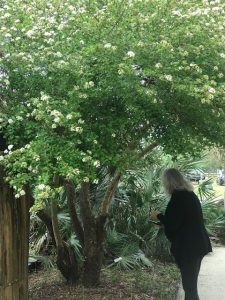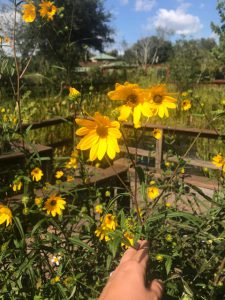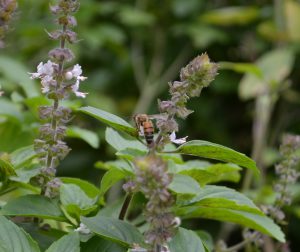Why should the Florida homeowner care about landscaping for honey bees and other wildlife?
The urban landscape is the largest expanding land use in FL. In late 2019, about 900 residents moved to Florida every day. With this expansion, what was once woodland or pasture areas are changing over to urban yards. When this happens wildlife can become displaced. But there’s a lot we can do in the urban landscape to provide for honey bees and other wildlife.
For information about honey bees or beekeeping check out the UF/IFAS Honey Bee Research & Extension Lab. http://www.ufhoneybee.com
What are some common barriers for landscaping for honey bees?
- Bee stings – A common concern about gardening for bees and other pollinators, is that you will encounter more stinging insects and therefore increase the chance of being stung. In reality, you are not likely to get stung when working around honey bees in the garden, unless you trap one against your body or accidentally grab a bee when pruning or harvesting flowers.
- Perception – The public perception that a bee garden or wildlife habitat will be messy or unkempt is a potential barrier, but doesn’t have to be. There are things you can do, like mulching and edging, to help the landscape fit into social norms while still providing for honey bees.
- Plant availability – Florida native wildflowers can sometimes be hard to find at a big box store, try a native plant nursery, a local retail garden center, or request the plant from a big box store. There are non-native plants that can provide good pollen sources too, like African blue basil, dill, or parsley.plant nursery, a local retail garden center, or request the plant from a big box store.
-

African blue basil attracts honey bees by the droves. Photo by Beth Bolles, UF IFAS Extension Escambia County. - Don’t use pesticides or greatly limit their use. Choose soaps and oils as they do not have a long residual, but even use these when bees are not actively foraging. If any spraying needs to take place, do so early in the morning or late in the evening. Avoid using dust formulations of pesticides as they can easily be picked up on the hairy bodies of bees.


What are simple steps homeowners can take to provide honey bee habitat?
- Simply grow more flowers in varying heights, widths, and variety
- Plant in a sunny location and group plants together, so bees use less energy searching for plants
- According to Oregon State University, honey bees are attracted to colors on the UV side of the light spectrum, think blue, purple, and white. They cannot see red, but they will feed and nectar on other colors including yellow. https://extension.oregonstate.edu/gardening/pollinators/create-home-landscape-pollinators-butterflies-bees-hummingbirds
- Plant umbel and daisy shaped flowers – The word umbel should remind you of umbrella, so think of flowers that provide this shape. Umbel shaped flowers are small flowers combining to make up one big flower cluster. This makes it easy for bees to land and collect pollen. Queen Anne’s lace from more northern climates is a good example of this type of flower head.
Tips to make a landscape for honey bees fit into a more traditional landscape
- Plant like flowers together and in mass. This can help insects locate their food source, plus it can make a landscape appear more tidy.
- Plant in odd numbers versus even numbers. The human eye needs somewhere to rest and if planting in odd numbers, your eye will rest on the most central plant.
-
- Tall, large, or interesting plants – plant 1
- Medium sized shrubs – plant in 3s, 5s, or 7s
- Wildflowers and perennials – plant in 5s, 7s, 9s, or more
- If you live in a deed restricted community keep landscape beds well defined by using edging and mulch.
- Design beds in natural and flowing lines, for example, consider the path of a stream or a woodland hiking trail. Avoid strong geometry in landscape bed design as the natural habit of a large variety of flowering plants will look odd in a formal garden.
If a resident lives in a yard with a small lot or patio, is it still possible to attract honey bees?
According to Dr. Jaret Daniels with the University of Florida’s Entomology & Nematology Department, even a small increase in diversity of plant material can increase diversity of pollinators. Start small by planting a container garden or a small landscape bed with honey bee and butterfly plants.
McGuire Center for Lepidoptera and Biodiversity Daniels Lab https://www.floridamuseum.ufl.edu/daniels-lab/
What plants provide nectar and pollen for honey bees in Florida?
Simply grow a wide variety of flowering plants. Honey bees will pollinate thousands of flowering species. Below is a list of just a few examples of flowering plants suited to the Florida landscape.


- Walter’s viburnum – white blooms in spring
- Yaupon holly ‘Nana’ – low growing cultivar, small flowers bloom along the stems in early spring
- Saw palmetto
- Gallberry
- Daisy shaped flowers like purple cone flower, blanket flower, & black-eyed Susan
- Fruit trees and vegetables – peaches, cucurbits like squash, cucumber, & watermelon
- Umbel flowers – dill, parsley, & fennel
- Snap dragons
- Herbs – basil, rosemary, & lavender
 2
2

